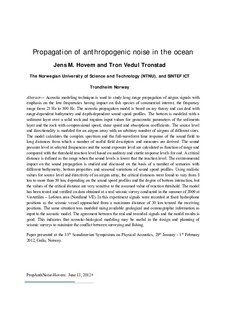| dc.description.abstract | Acoustic modeling technique is used to study long range propagation of airgun signals with emphasis on the low frequencies having impact on fish species of commercial interest, the frequency range from 25 Hz to 300 Hz. The acoustic propagation model is based on ray theory and can deal with range-dependent bathymetry and depth-dependent sound speed profiles. The bottom is modeled with a sediment layer over a solid rock and requires input values for geoacoustic parameters of the sediments layer and the rock with compressional speed, shear speed and absorptions coefficients. The source level and directionality is modeled for an airgun array with an arbitrary number of airguns of different sizes. The model calculates the complex spectrum and the full-waveform time response of the sound field to long distances from which a number of useful field descriptors and measures are derived. The sound pressure level at selected frequencies and the sound exposure level are calculated as function of range and compared with the threshold reaction level based on auditory and startle response levels for cod. A critical distance is defined as the range when the sound levels is lower that the reaction level. The environmental impact on the sound propagation is studied and discussed on the basis of a number of scenarios with different bathymetry, bottom properties and seasonal variations of sound speed profiles. Using realistic values for source level and directivity of an airgun array, the critical distances were found to vary from 8 km to more than 50 km, depending on the sound speed profiles and the degree of bottom interaction, but the values of the critical distance are very sensitive to the assumed value of reaction threshold. The model has been tested and verified on data obtained at a real seismic survey conducted in the summer of 2009 at Vesterålen – Lofoten area (Nordland VII). In this experiment signals were recorded at fixed hydrophone positions as the seismic vessel approached from a maximum distance of 30 km toward the receiving positions. The same situation was modeled using available geological and oceanographic information as input to the acoustic model. The agreement between the real and recorded signals and the model results is good. This indicates that acoustic-biological modeling may be useful in the design and planning of seismic surveys to minimize the conflict between surveying and fishing. | nb_NO |
